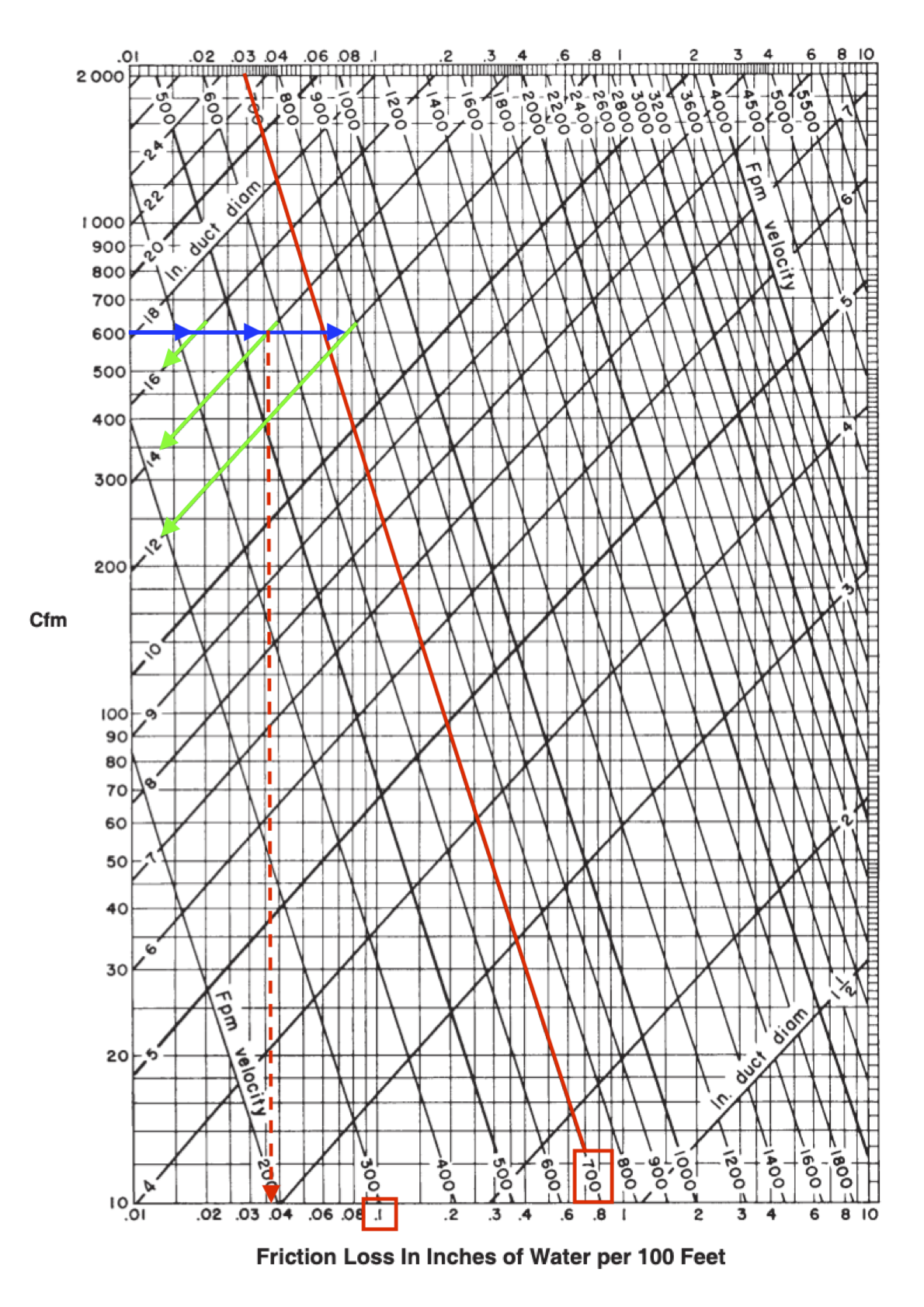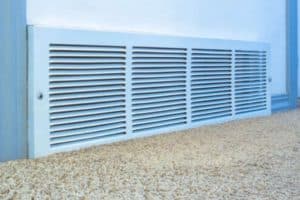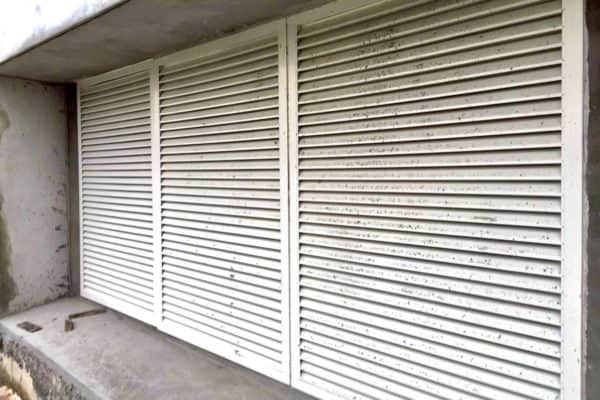Return Duct Size for HVAC Unit (Sizing Chart & How-to Guide)
Return duct sizes are primarily depending on the airflow of the HVAC unit which is corresponding to the tonnage or capacity of the HVAC unit. The larger the HVAC unit, the bigger the return duct. However, velocity is a critical factor as it affects the noise level. So, I made a return duct size chart as well as a guide on how to determine the right return duct size.
According to the ACCA Manual D guideline, the air velocity in a return duct should not exceed 700 feet per minute for noise control. Therefore, the corresponding return duct size for round rigid duct, round flexible duct and rectangular rigid duct are as follows:
| Unit Size (Ton) | Airflow (CFM) | Round RIGID Duct (Inch) | Qty |
|---|---|---|---|
| 1.5 | 600 | 14 | 1 |
| 2.0 | 800 | 12 | 2 |
| 2.5 | 1000 | 12 | 2 |
| 3.0 | 1200 | 14 | 2 |
| 3.5 | 1400 | 14 | 2 |
| 4.0 | 1600 | 12 | 3 |
| 5.0 | 2000 | 14 | 3 |
| Unit Size (Ton) | Airflow (CFM) | Rectangular RIGID Duct (Inch) |
|---|---|---|
| 1.5 | 600 | 8×18 |
| 2.0 | 800 | 10×18 |
| 2.5 | 1000 | 12×20 |
| 3.0 | 1200 | 12×22 |
| 3.5 | 1400 | 12×26 |
| 4.0 | 1600 | 12×32 |
| 5.0 | 2000 | 12×40 |
| Unit Size (Ton) | Airflow (CFM) | Round FLEXIBLE Duct (Inch) | Qty |
|---|---|---|---|
| 1.5 | 600 | 16″ | 1 |
| 2.0 | 800 | 14″ | 2 |
| 2.5 | 1000 | 14″ | 2 |
| 3.0 | 1200 | 16″ | 2 |
| 3.5 | 1400 | 16″ | 2 |
| 4.0 | 1600 | 14″ | 3 |
| 5.0 | 2000 | 16″ | 3 |
Other than the above listed sizes, there are many more sizes that you can use depending on how much space you have, how convenient you can get the duct and which type of duct you prefer. In the following, I’ll explain how you can finalize your return duct based on your requirements.
How to Determine Return Duct Size?
The first step is about the size of your HVAC unit. Typically, central air conditioners are sized based on how many cooling tons your house needs. For instance, 2 tons, 3 tons or even 5 tons. This is normally correspond to the size of your house. See HVAC unit sizing guide here.
Air conditioning ducts are sized based on how much airflow your HVAC unit has. Generally, we can estimate the airflow of an HVAC unit based on 400 cubic feet per minute (CFM) per ton. So, if you have a 2-ton unit, the airflow will be around 800 CFM.
Now, we want to select a duct size that has the capacity to carry 800 CFM. For return air ducts, the ACCA or Air Conditioning Contractors of America suggest the air velocity within the duct should not exceed 700 feet per minute (FPM) for noise control.
The higher the air velocity, the noisier the return duct.
The Darcy and Colebrook Equations is the primary formula used to determine duct size for a given set of design criteria. Because the formula is complicated, tools and duct sizing software has been developed and we, engineers use that to speed up the work.
As a result of my simplification, the above tables can be used to find the duct size based on the tonnage of your HVAC unit.
Understanding the Return Duct Size Chart
Round RIGID Duct
The table on the right (or below if you’re viewing on a phone) shows the return duct size for HVAC unit from 1.5 tons to 5 tons. Based on 400 CFM per ton, the corresponding airflow is also provided. The next column is the diameter (in inch) for ROUND RIGID duct. The last column is the number of round rigid duct you need.
In practice, the airflow of your HVAC unit will vary based on many factors. Nonetheless, the duct size shown here should be able to handle them.
I limit the duct size to 14″ because that’s what you normally can get from online stores and Home Depot. If you appoint a contractor, they should be able to get you something bigger than 14″. In that case, you don’t need so many return ducts.
| Unit Size (Ton) | Airflow (CFM) | Round RIGID Duct (Inch) | Qty |
|---|---|---|---|
| 1.5 | 600 | 14 | 1 |
| 2.0 | 800 | 12 | 2 |
| 2.5 | 1000 | 12 | 2 |
| 3.0 | 1200 | 14 | 2 |
| 3.5 | 1400 | 14 | 2 |
| 4.0 | 1600 | 12 | 3 |
| 5.0 | 2000 | 14 | 3 |
If you have access to size bigger than 14″, here is what you need based on ONE return duct (qty=1):
- 800 cfm = 16″
- 1000 & 1200 cfm = 18″
- 1400 cfm = 20″
- 1600 cfm = 22″
- 2000 cfm = 24″
Again, these duct sizes are strictly based on an air velocity of below 700 fpm (as per ACCA). Of course, you can use a smaller duct and allow a greater velocity at the expense of a greater noise level. How much more noise will be produced versus the velocity increase has not been officially tested. So, we don’t know how noisy will it be when the velocity is increased.
One example that I can give is using a 16″ duct for 1000 cfm. The resulting velocity is 750 fpm, merely 50 fpm more than the guideline. For me, that’s a go. Another similar example is using a 18″ duct for 1400 cfm. The resulting velocity is 800 fpm.
The same applies to rectangular and flexible ducts in the following. If you want to see the duct sizes that exceed 700 fpm, I have attached a table at the end of this post.
Rectangular RIGID Duct
The next table on the right (or below if you’re viewing on a phone) shows the return duct size for HVAC unit from 1.5 tons to 5 tons for RECTANGULAR RIGID duct. For this type of duct, you only need one.
If you choose to use a rectangular duct, you have many options. The sizes I provided here are based on standard duct sizes and I’ve taken into consideration the space available in the house. If you find the size doesn’t fit your house, feel free to alter it.
To calculate the equivalent duct size, we can convert the rectangular duct size into equivalent diameter and then work backward to find the equivalent length and width. Here is how:
| Unit Size (Ton) | Airflow (CFM) | Rectangular RIGID Duct (Inch) | Equivalent Diameter (Inch) |
|---|---|---|---|
| 1.5 | 600 | 8×18 | 12.5 |
| 2.0 | 800 | 10×18 | 14.5 |
| 2.5 | 1000 | 12×20 | 16.2 |
| 3.0 | 1200 | 12×22 | 17.7 |
| 3.5 | 1400 | 12×26 | 19.1 |
| 4.0 | 1600 | 12×32 | 20.5 |
| 5.0 | 2000 | 12×40 | 22.9 |
Let say you have a 3-ton HVAC unit and the airflow is about 1200 cfm. Your return air closet only can fit a 10″ wide duct. So, let’s try to use a 10×28 duct and see if the performance is equivalent to the 12×22 duct:
Equivalent diameter = [1.3 x (ab)0.625] / [(a+b)0.25]
Equivalent diameter = [1.3 x (10×28)0.625] / [(10+28)0.25]
Equivalent diameter = 43.99 / 2.48
Equivalent diameter = 17.7 inches (should be equal or more than the number in the table)
We’re lucky to get the equivalent duct in one try. So, instead of 12×22, we can use 10×28, knowing that we’re getting the same airflow capacity and velocity (noise).
For you convenience, use the below calculator to calculate the equivalent diameter:
Round FLEXIBLE Duct
The last table on the right (or below if you’re viewing on a phone) shows the return duct size for HVAC unit from 1.5 tons to 5 tons for ROUND FLEXIBLE duct. If you choose to use flexible ducts for your return, you need to increase the size because of the increased roughness of the duct inner surface.
Given the same duct size, airflow and velocity, the amount of friction loss (air resistance) in a flexible duct is about 35% more than a round rigid duct. This is before accounting for any compression that flexible ducts are susceptible to.
Assume that the distance from the return grille to the HVAC unit is 10 feet. When installing the flexible duct, we’re likely to prepare 11 feet while leaving 1 feet for buffer, in case not enough long. With that, the flexible duct is 9% compressed. As a result, the friction loss increased by 3 times on average compared to a round rigid duct.
| Unit Size (Ton) | Airflow (CFM) | Round FLEXIBLE Duct (Inch) | Qty |
|---|---|---|---|
| 1.5 | 600 | 16″ | 1 |
| 2.0 | 800 | 14″ | 2 |
| 2.5 | 1000 | 14″ | 2 |
| 3.0 | 1200 | 16″ | 2 |
| 3.5 | 1400 | 16″ | 2 |
| 4.0 | 1600 | 14″ | 3 |
| 5.0 | 2000 | 16″ | 3 |
So, to equalize the friction loss, in short, we simply need to use a flexible duct that is one size bigger than its equivalent round rigid duct.
Fortunately, it is generally easier to get a bigger size flexible duct from convenient stores. However, you still need multiple ducts to accommodate the large airflow that your HVAC unit needs. Otherwise, the noise and friction loss (which reduces your airflow) will have a significant impact on the performance of your HVAC system.
So, I generally don’t recommend using flexible ducts for large return airflow. Round rigid ducts are decent and a rectangular rigid duct is the best if you have only one return. Don’t forget to get an adequately-sized return air grille for noise control as well.
Similarly, if you have access to bigger sizes, here is what you need to strive for ONE duct (qty=1) at the same friction loss as a round rigid duct:
- 800 cfm = 18″
- 1000 & 1200 cfm = 20″
- 1400 cfm = 22″
- 1600 cfm = 24″
- 2000 cfm = 26″
Flexible duct sizes above 16″ are difficult to find. You may have a better chance at duct specialist stores. Nonetheless, the largest flexible duct I believe is 24″.
Sizing with a Friction Loss Chart
The tables listed in this post are for your convenience. In reality, duct sizing is much more complicated. If you don’t mind a little engineering work, then you can make a better decision by using the duct sizing friction loss chart.
The chart on the right (or below if you’re viewing on a phone) is the friction loss chart for round rigid duct. I’ve indicated an example using colored lines. Here is how it works:
The diagonal solid red line is the velocity limit. You can see I draw the red line exactly at 700 fpm. Next is the blue line. There are 3 blue lines at 600 cfm, representing 3 possible duct sizes as indicated by the 3 green lines which corresponds to 16″, 14″ and 12″ respectively.
First, if we use a 16″ duct for 600 cfm, it is considered oversized and it is not necessary because we have a smaller size which is 14″ available. When we use a 14″ duct to carry 600 cfm, the resulting velocity is well under the 700 fpm limit. Additionally, we also want to check the friction loss which is indicated by the red dotted line. Generally, we don’t want the friction loss to exceed 0.1 inch of water per 100 feet. For 600 cfm, 14″ duct results in a friction loss of about 0.035 inch of water per 100 feet.

Let’s see what happens if we use a 12″ duct. From the chart, we can see that 12″ duct results in the velocity exceeding 700 fpm. Although the friction loss is below 0.1 inch of water per 100 feet, the high velocity could lead to noise. Again, slightly higher velocity may not have a noticeable difference.
In terms of the friction loss, all duct sizes I provided in the above tables result in a friction loss well under 0.1 inch of water per 100 feet. So, if you’re calculating the static pressure for the HVAC fan, these duct sizes won’t give you a high static pressure requirement.
Return Duct Size Chart (Velocity >700 FPM)
Below tables provide the possible return duct sizes for different HVAC units. The first size is the recommended size and the following two sizes are smaller. The corresponding velocity and friction loss are stated for all sizes. For flexible duct, the friction loss based on 0%, 5% and 10% compression are provided. Choose your preferred return duct size based on the information given.
1.5-Ton | 600 CFM
Rigid Duct
| Duct Size (Inch) | Velocity (fpm) | Friction Loss (in.wg/100ft) |
|---|---|---|
| 14 | 560 | 0.037 |
| 12 | 765 | 0.079 |
| 10 | 1100 | 0.195 |
Flexible Duct
| Duct Size (Inch) | Velocity (fpm) | Friction Loss at 0% Compression (in.wg/100ft) | Friction Loss at 5% Compression (in.wg/100ft) | Friction Loss at 10% Compression (in.wg/100ft) |
|---|---|---|---|---|
| 16 | 425 | 0.023 | 0.032 | 0.042 |
| 14 | 560 | 0.047 | 0.071 | 0.094 |
| 12 | 765 | 0.106 | 0.173 | 0.241 |
2-Ton | 800 CFM
Rigid Duct
| Duct Size (Inch) | Velocity (fpm) | Friction Loss (in.wg/100ft) |
|---|---|---|
| 16 | 575 | 0.033 |
| 14 | 750 | 0.063 |
| 12 | 1020 | 0.135 |
Flexible Duct
| Duct Size (Inch) | Velocity (fpm) | Friction Loss at 0% Compression (in.wg/100ft) | Friction Loss at 5% Compression (in.wg/100ft) | Friction Loss at 10% Compression (in.wg/100ft) |
|---|---|---|---|---|
| 18 | 455 | 0.023 | 0.030 | 0.037 |
| 16 | 575 | 0.042 | 0.058 | 0.074 |
| 14 | 750 | 0.083 | 0.125 | 0.166 |
2.5-Ton | 1000 CFM
Rigid Duct
| Duct Size (Inch) | Velocity (fpm) | Friction Loss (in.wg/100ft) |
|---|---|---|
| 18 | 565 | 0.027 |
| 16 | 715 | 0.049 |
| 14 | 935 | 0.095 |
Flexible Duct
| Duct Size (Inch) | Velocity (fpm) | Friction Loss at 0% Compression (in.wg/100ft) | Friction Loss at 5% Compression (in.wg/100ft) | Friction Loss at 10% Compression (in.wg/100ft) |
|---|---|---|---|---|
| 20 | 460 | 0.021 | 0.025 | 0.030 |
| 18 | 565 | 0.035 | 0.045 | 0.056 |
| 16 | 715 | 0.064 | 0.089 | 0.114 |
3-Ton | 1200 CFM
Rigid Duct
| Duct Size (Inch) | Velocity (fpm) | Friction Loss (in.wg/100ft) |
|---|---|---|
| 18 | 680 | 0.039 |
| 16 | 860 | 0.069 |
| 14 | 1120 | 0.133 |
Flexible Duct
| Duct Size (Inch) | Velocity (fpm) | Friction Loss at 0% Compression (in.wg/100ft) | Friction Loss at 5% Compression (in.wg/100ft) | Friction Loss at 10% Compression (in.wg/100ft) |
|---|---|---|---|---|
| 20 | 550 | 0.029 | 0.036 | 0.043 |
| 18 | 680 | 0.050 | 0.065 | 0.080 |
| 16 | 860 | 0.069 | 0.127 | 0.163 |
3.5-Ton | 1400 CFM
Rigid Duct
| Duct Size (Inch) | Velocity (fpm) | Friction Loss (in.wg/100ft) |
|---|---|---|
| 20 | 640 | 0.030 |
| 18 | 790 | 0.051 |
| 16 | 1005 | 0.092 |
Flexible Duct
| Duct Size (Inch) | Velocity (fpm) | Friction Loss at 0% Compression (in.wg/100ft) | Friction Loss at 5% Compression (in.wg/100ft) | Friction Loss at 10% Compression (in.wg/100ft) |
|---|---|---|---|---|
| 22 | 530 | 0.024 | 0.028 | 0.033 |
| 20 | 640 | 0.039 | 0.048 | 0.057 |
| 18 | 790 | 0.067 | 0.087 | 0.107 |
4-Ton | 1600 CFM
Rigid Duct
| Duct Size (Inch) | Velocity (fpm) | Friction Loss (in.wg/100ft) |
|---|---|---|
| 22 | 605 | 0.024 |
| 20 | 735 | 0.039 |
| 18 | 905 | 0.066 |
Flexible Duct
| Duct Size (Inch) | Velocity (fpm) | Friction Loss at 0% Compression (in.wg/100ft) | Friction Loss at 5% Compression (in.wg/100ft) | Friction Loss at 10% Compression (in.wg/100ft) |
|---|---|---|---|---|
| 24 | 510 | 0.020 | 0.023 | 0.026 |
| 22 | 605 | 0.031 | 0.037 | 0.042 |
| 20 | 735 | 0.051 | 0.063 | 0.075 |
5-Ton | 2000 CFM
Rigid Duct
| Duct Size (Inch) | Velocity (fpm) | Friction Loss (in.wg/100ft) |
|---|---|---|
| 24 | 635 | 0.024 |
| 22 | 760 | 0.037 |
| 20 | 915 | 0.059 |
Flexible Duct
| Duct Size (Inch) | Velocity (fpm) | Friction Loss at 0% Compression (in.wg/100ft) | Friction Loss at 5% Compression (in.wg/100ft) | Friction Loss at 10% Compression (in.wg/100ft) |
|---|---|---|---|---|
| 26 | 540 | 0.020 | 0.022 | 0.025 |
| 24 | 635 | 0.030 | 0.035 | 0.039 |
| 22 | 760 | 0.048 | 0.057 | 0.066 |
Rectangular Duct Based on Limited Width (Velocity <700 FPM)
For rectangular rigid duct, follow the formula or use the calculator I’ve provided earlier to find the equivalent width and length. For your convenience, here are a few sample sizes:
| Unit Size (Ton) | Airflow (CFM) | Equivalent Diameter (Inch) | 8″ Width | 10″ Width | 12″ Width | 14″ Width |
|---|---|---|---|---|---|---|
| 1.5 | 600 | 12.5 | 8×18 | 10×14 | 12×12 | 14×10 |
| 2.0 | 800 | 14.5 | 8×24 | 10×18 | 12×16 | 14×14 |
| 2.5 | 1000 | 16.2 | 8×30 | 10×24 | 12×20 | 14×16 |
| 3.0 | 1200 | 17.7 | – | 10×28 | 12×22 | 14×20 |
| 3.5 | 1400 | 19.1 | – | 10×34 | 12×26 | 14×22 |
| 4.0 | 1600 | 20.5 | – | 10×40 | 12×32 | 14×26 |
| 5.0 | 2000 | 22.9 | – | – | 12×40 | 14×34 |
With that, I end my post here. If you still have doubt, feel free to consult me.
If you have anything to add (or ask) about this topic, leave a comment down below!









